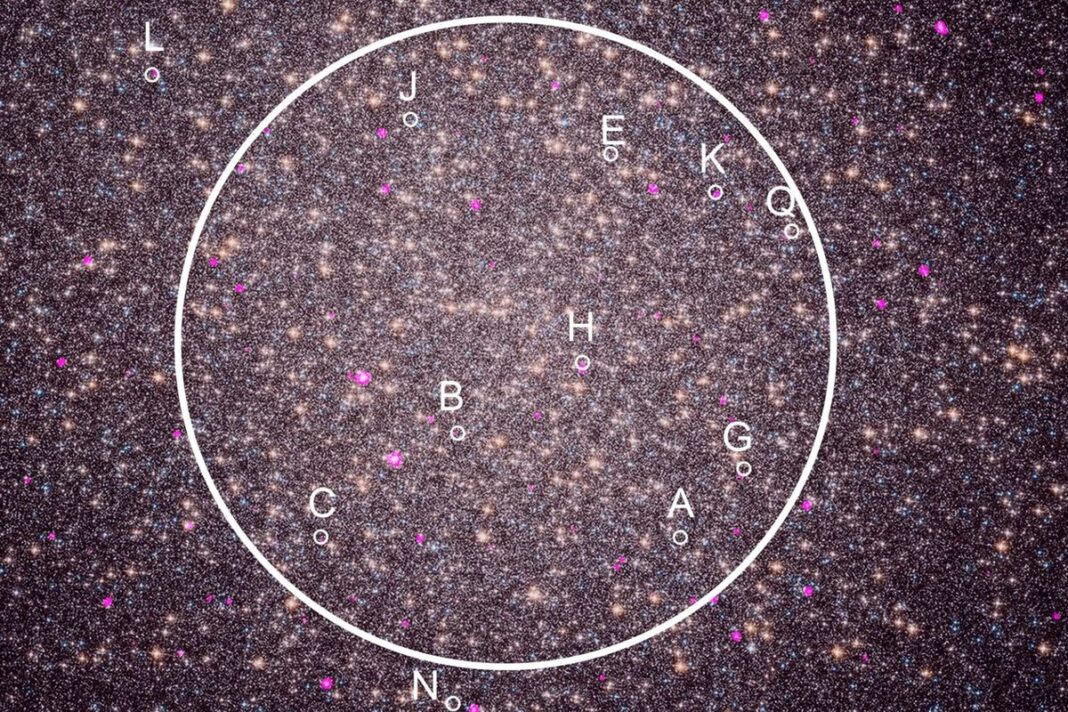A group of dead stars known as “spider pulsars” has been discovered to be within the Omega Centauri globular cluster, revealed NASA in a . Fueled by data from NASA’s Chandra X-ray Observatory, the research, led by astronomers from the University of Alberta in Canada, has shed light on the predatory behavior of these peculiar celestial entities located a distant 17,700 light years from Earth. A pulsar— the remnants of a massive star’s collapse into a neutron star— becomes a millisecond pulsar when it rapidly rotates, emitting beams of radiation similar to a lighthouse beam.
Spider pulsars, a special subclass of these, earned their name from the systematic damage they inflict upon their smaller companion stars. The pulsars strip away the outer layers of their companions through winds of energetic particles they emit. Through the looking glass and pouring over data Recent astronomical discoveries have added depth to our understanding of these cosmic predators.
Using the Parkes and MeerKAT radio telescopes, astronomers identified 18-millisecond pulsars within Omega Centauri. A subsequent analysis of Chandra data revealed that 11 of these pulsars emit X-rays, with a subset of five identified as spider pulsars concentrated near the cluster’s center. To bolster their findings, researchers combined the data of Omega Centauri with of 26 spider pulsars across 12 other globular clusters.
Researchers Jiaqi (Jake) Zhao and Craig Heinke from the University of Alberta in Canada identified two distinct types of spider pulsars based on the mass of the companion stars they obliterate. “Redback” spider pulsars inflict damage on companion stars weighing between a tenth and half the mass of the Sun, while “black widow” spider pulsars target companions with less than 5 percent of the Sun’s mass. Notably, the redbacks exhibited greater X-ray brightness than their black widow counterparts, confirming previous research.
The research represents the first time a general correlation between X-ray brightness and the companion mass for spider pulses has been established. Cosmic proximity and colliding winds The team believes that radiation captured by Chandra is a result of these winds of particles flowing away from the pulsars colliding with winds of matter blowing away from companion stars, producing shock waves akin to those from . The proximity between spider pulsars and their companions, a mere one to 14 times the distance from Earth to the Moon, plays a pivotal role in the destructive process, inflicting more damage the greater their proximity.
These findings align with theoretical models which state that the mass of companion stars influences the X-ray dose received. More massive stars produce denser particle winds, leading to more significant shockwaves and brighter X-rays upon collision. Chandra’s sharp X-ray vision was essential in studying millisecond pulsars within globular clusters.
These clusters, containing numerous X-ray sources in a confined region of the sky, pose challenges in source differentiation, which could be navigated given Chandra’s precise observations. The research team’s findings are published in the open-access repository . Millisecond pulsars (MSPs) are faint X-ray sources commonly observed in Galactic globular clusters (GCs).
In this work, we investigate 18 MSPs newly found in the GC Omega Centauri (ω Cen) and search for their X-ray counterparts using Chandra observations with a total exposure time of 290. 9 ks. We identify confident X-ray counterparts for 11 of the MSPs, with 9 of them newly identified in this work based on their positions, spectral properties, and X-ray colours.
The X-ray spectra of 9 MSPs are well described by a neutron star hydrogen atmosphere model, while 2 MSPs are well fitted by a power-law model. The identified MSPs have X-ray luminosities ranging from 1. 0×1030 erg s−1 to 1.
4×1031 erg s−1. Additionally, for population comparison purposes, we study the X-ray counterpart to MSP E in the GC M71, and find its X-ray spectrum is well described by blackbody-like models with a luminosity of 1. 9×1030 erg s−1.
We investigate the empirical correlations between X-ray luminosities and minimum companion masses, as well as mass functions, of spider pulsars. Clear correlations are observed, with best-fit functions of log10LX=(1. 0±0.
1)log10Mc,min+(32. 5±0. 2) and log10LX=(0.
35±0. 04)log10MF+(32. 71±0.
20), respectively, with an intrinsic scatter of log10LX of ∼0. 3, where LX is the 0. 5−10 keV X-ray luminosity, Mc,min is the minimum companion mass, and MF represents the mass function, in solar masses.
.
From: interestingengineering
URL: https://interestingengineering.com/science/murderous-spider-pulsars-are-destroying-stars-says-new-research



